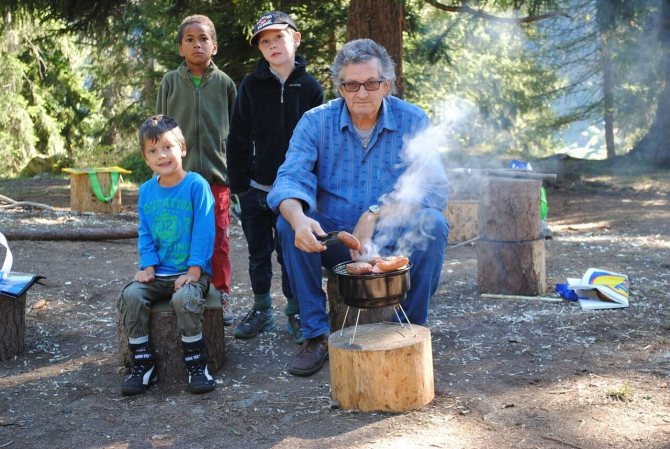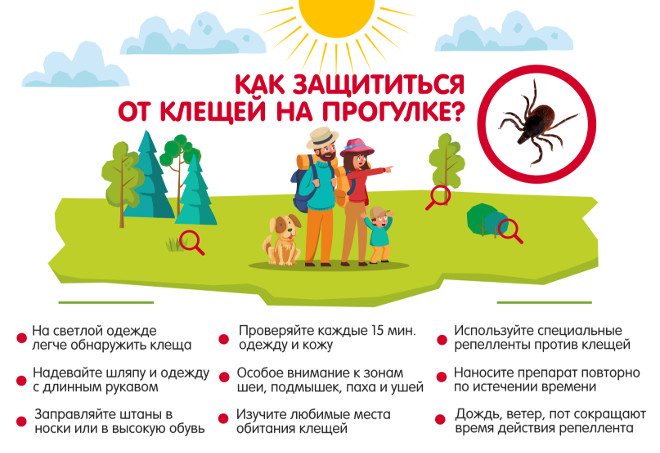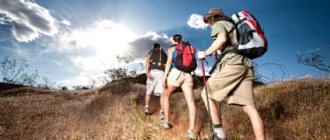Summer is a great holiday time for adults and children. Getting away from the city noise and smog, it’s so wonderful to hold various events in the forest. For children, any trip to the forest in the summer turns into an exciting adventure, full of riddles and secrets. There are so many interesting and unknown things around, and children’s curiosity takes over. If you do not follow the rules of behavior in the forest, such a trip can turn tragic for children. There are a number of rules and regulations that children must strictly follow to stay safe.
Safety regulations
If you go for a walk in the forest, carefully study the rules, following which you can ensure safety in the forest for children:
- Before you go on a hike, let your loved ones know where you are going. Knowing this, relatives will be able to seek help if necessary.
- Take dry matches, a watch and a compass on the road. Place a small knife in your pocket. It is possible that all this will come in handy on a forest walk.
- Bring extra food and water with you in case of delay. You should not eat unfamiliar berries or drink water from unknown sources.
- Wear bright outerwear, preferably with reflective details, so it will be easier for rescuers to notice you.
- Determine your route and stick to it at all times. There is no need to take shortcuts to get there faster if that means going through a swamp.
- If you have lost a friend, call rescuers immediately. There is no need to try to search on your own; you can destroy traces that will help in the search.
- Try to shout to the lost person, but try to stay in place.
- Bring first aid supplies on your hike. They may come in handy if someone gets sick.
- Inspect the road you are walking on so as not to fall into a hole and break your leg. Forest paths are not always well-trodden, this should not be forgotten.
- Don't leave trash behind, dig a hole in the ground and bury it. Never leave glass shards in the forest.
- Do not make a fire near trees; move at least 1.5 meters away from them. If you have a fireplace, you should not build a new one.
- When getting ready to go home, carefully extinguish the fire so that it does not start again after you leave. It is advisable to cover the fire with earth without scattering coals.
Stories for preschoolers on safe behavior in nature
STORIES FOR PRESCHOOL CHILDREN
ON SAFE BEHAVIOR IN NATURE
HOW VANYA GOT LOST IN THE FOREST
In the summer, Vanya and his grandmother lived in the country. One day this is what happened to him. Grandma was busy with her own affairs, and Vanya was playing in the sandbox.
Suddenly he heard a loud “cuckoo, cuckoo!” Vanya really wanted to look at the cuckoo. And he decided to go into the forest, which began immediately behind their house. Vanya walked through the forest and looked at the trees. It seemed that the cuckoo was somewhere very close. But the cuckoo fell silent. Vanya looked around and got scared. He didn't know where to go next.
There are tall trees around, but the house is not visible at all. Vanya began to cry and ran wherever he could.
Luckily, a smart squirrel lived in the forest.
“Stop, Vanya! - the squirrel screamed. -Why did you go into the forest alone? And if you get lost, stand still and loudly shout “Ay!”
Vanya did just that. Grandma heard him. She was already looking for him: she realized that something bad had happened to her grandson. Grandmother found Vanya and they returned home. Vanya promised that he would never go into the forest without adults again.
- What happened to Vanya?
- Who helped him?
- How did the squirrel help Vanya?
FLY AKOMOR
One day Vanya and his grandmother went into the forest to pick mushrooms. Grandmother showed Vanya mushrooms and taught how to carefully cut them. The basket was almost full. And then Vanya saw an unusually beautiful mushroom. His hat was red with white dots. “Grandma, look what a beautiful mushroom I found!”
But the grandmother explained that this mushroom, although beautiful, is poisonous.
Vanya wanted to kick the bad mushroom, but his grandmother stopped him: “The fly agaric is dangerous for humans, and forest animals are treated with it, like people with medicine.”
- What mushroom did Vanya find in the forest?
- Why can't you eat fly agarics?
- Who is treated with fly agarics?
ICE PILE
On New Year's holidays, Vanya and his sister Masha came to visit their grandmother in the village. There was a river not far from her house. The river froze, and the children wanted to run on the frozen river, but their grandmother did not allow them. She said that on the river, so that the fish do not die, people make ice holes. If you don't notice the hole, you'll end up in icy water. It is dangerous to play on the ice of rivers and lakes.
- Why didn't grandma allow the children to play on the frozen river?
FIRE
Autumn has come. The leaves on the trees turned yellow. When the wind blew, they fell from the branches and slowly circled in the air. True, the days were still warm.
Over the weekend, Kirill and Vanya and their parents came to visit their grandmother in the village.
After resting, they went to the forest, which began immediately behind the village.
In this forest, in a hollow in an old pine tree, there lived a squirrel. The boys screamed loudly, and the squirrel was scared in its house. But that was not so bad.
Kirill and Vanya collected dry branches and lit a fire. The wind threw the flames of the fire onto the dry grass, and the grass caught fire. The boys got scared and ran away. The fire reached the old pine tree where the squirrel lived. The little squirrel had to quickly escape and run further into the forest.
It’s good that the firefighters arrived and put out the fire.
When the squirrel returned, she did not recognize her pine tree: it was black. The trees and grass around also turned black. The squirrel grieved, and went to look for a new home.
Kirill and Vanya were ashamed of their rash act.
- Why did the fire start in the forest?
ICE DRIVE
Vanya and dad went to watch the ice drift that happens in the spring. The ice on the river begins to melt, and huge ice floes float downstream.
The ice near the shore seemed to be still strong. Vanya suggested that dad walk along it closer to the floating ice floes.
But dad explained that in spring and even in winter it is dangerous to stand on the ice of the river. The ice may turn out to be fragile, and a person will fall into the water.
- Why is it dangerous to walk on river ice?
STORM
Hot summer days have arrived. Vanya and grandmother came to the river to swim. Suddenly a thunderstorm began. Grandma took Vanya ashore. She explained: if lightning strikes water, a person can be seriously injured. It's dangerous on the river during a thunderstorm.
Vanya offered to hide from the rain under a tall willow tree that grew on the shore, but his grandmother did not allow him and took him to the bushes.
During a thunderstorm, you should not hide under tall trees. They are often struck by lightning.
- Why didn’t grandma allow Vanya to swim in a thunderstorm?
- Why can't you hide under tall trees during a thunderstorm?
Rules of behavior in the forest
While in the forest, children must follow a number of simple rules of behavior:
- Stay constantly close to your loved ones, or within their visibility range.
- Do not pick or try unknown berries and mushrooms, they can be poisonous.
- Do not touch animals or insects. They can bite or carry serious infections. Do not pet or handle small cubs, as this can lead to serious consequences.
- Do not go close to lakes and reservoirs, and do not go into the water without adult permission. Water can hide many secrets, you need to remember this.
- At the first danger, immediately call an adult. There is no need to try to cope with the problem on your own; adult help will definitely come in handy.
Safety rules for fire in the forest
Being vigilant while relaxing near a forest can save not only your health, but also your life. Dangers in the forest are warned especially often in spring and summer. The proximity of fire danger in the forest can be monitored by the following signs:
- the appearance of a burning smell;
- smoke, in the absence of fog;
- alarming behavior of forest inhabitants;
- frantic movement of birds in one direction;
- fiery reflections on the horizon, especially at night.
If at least one of these atypical phenomena occurs, you should immediately call 112.
You can begin to provide first fire protection assistance to the forest yourself. But only if the scale of the fire is small. You can extinguish fires if:
- put out the fire with fresh branches, thick clothing, a blanket, a bedspread, and so on;
- to fill with water;
- cover with damp turf;
- trample.
If the peat bog is on fire:
- to fill with water;
- dig up a layer of peat.
Important! When extinguishing a ground fire, voids may form under the soil, so you should move with caution.
When deciding to extinguish a fire yourself, you need to take into account the speed of its spread. You should also stick together and be constantly in touch. It is better not to go far from the reservoir, if there is one. Or choose open areas of the forest, a road. The correct safety measure is to immediately leave the area.
Reminder in pictures for preschoolers
When going for a walk in the forest, it would not be superfluous to once again remind preschool children about safe behavior in the forest. For children, rules of behavior and safety in the forest have been developed in pictures.
Each drawing is bright and catchy, attracts the child’s attention; stories in pictures about safety in the forest for children can be written in a convenient poetic form and are better remembered by children.
For example:
“You can’t throw glass in the forest, You can’t break bottles; Sharp fragments are dangerous - you will cut yourself terribly on them.”
By studying pictures in the form of a game, the child easily learns what can and cannot be done during forest walks. Compliance with forest laws is the key to the safety of adults and children.
The rules of behavior in nature for children, shown in the pictures, clearly demonstrate to the child how to behave so that trouble does not happen.
We organize the trip correctly
Children are curious and spontaneous creatures. No matter how well they learn the rules of behavior in the forest, once they are “in place” they can simply forget, get confused or get carried away by new experiences. Therefore, all responsibility falls on the shoulders of adults. Safety in the forest depends not only on the rules of behavior, but also on the organization of the trip. Adults should approach this with all seriousness, without missing a single important detail:
- Choosing a location. There are no “unexplored paths”; the hiking location must be safe, repeatedly traveled and known to the adults accompanying the children. You should not go deep into the forest, even if you know these places well. Wildlife is unpredictable.
- It's time to go. Choose the first half of the day for a hike in the forest. Don't forget that it gets dark in the forest earlier than in the city. The approaching twilight may make it difficult for you to get your bearings.
- Provisions. When going on a hike in the forest, take care of a snack. No raw meat - making a fire in a forest area is prohibited and dangerous. Let it be bread, salads, canned food, sausages and cheeses. Don't forget about drinking water. There should be enough of it, as well as food.
- Protection from insects. Everyone knows that there are much more bugs and mosquitoes of all kinds in the forest than in the city. Therefore, the backpack should have ointments, insect repellent sprays, and children (as well as you) should have scarves, panama hats and caps on their heads.
- Ratio of adults to children. There should be a lot of adults. Even if one or two teachers can easily cope with an entire class in the theater and museum, when going into the forest, enlist the support of parents and other teachers. Even the most obedient children in nature, when relaxing, behave more actively. Curiosity pushes children to violate even the strictest prohibitions, so they need to be monitored every minute. The younger the children, the more accompanying persons there should be. For a group of preschoolers, the ratio should ideally be “1 adult to 5 children.”
Etiquette and rules of behavior for children at the table
In addition, you should have all the necessary items on hand:
- Knife;
- Matches;
- Compass;
- Fully charged phone and portable battery, if available;
- Flashlight;
- First aid kit.

How to protect yourself from tick bites
The safety of children while walking in the forest directly depends on the attentiveness and responsibility of adults. Tick habitats cannot be determined visually. Therefore, it is important to know how to avoid their bites.
You need to dress your child correctly. White clothing on which ticks can be seen immediately is ideal. Completely protect your legs with high socks or tights, and tuck a T-shirt into them. Outerwear must have elastic bands, shoes must be completely closed, and a hat or scarf must be placed on the head.
It is necessary to take with you special preparations – repellents, which are periodically applied to the baby’s clothes. The child should be periodically examined to identify unwanted insects.
If, even with all the precautions taken, the baby is bitten by a tick, you must bring the insect for analysis. If analysis is not possible, the date of the bite should be recorded and the child monitored for three weeks. A runny nose, swelling or rash requires immediate medical attention.











